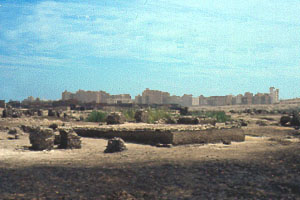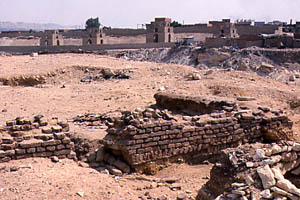|
In the middle of modern Cairo, close to the
Roman fortifications of Babylon and the Jewish and early Christian settlements
in the area, the Arab invaders pitched their tents. Centered around the
still existing mosque of Amr Ibn al-As, this camp grew into a city called
Fustat but now in ruins:
|
|
South-east of the ruins of Fustat, four of the
seven Fatimid tombs called 'the Seven Sisters' (Seba Binaat) can still
be seen. Between those and Fustat are an unfinished building project, including
a four-lane motor way, and another set of ruins contemporary with the later
phases of Fustat:
|
|
|
|
|

|
|

|
|
|
|
|
|
|
|
|
Objective of visit:
|
|
To add the newly exposed parts of the Arab settlements
in Egypt to the existing maps of Fustat. |
|
Date of visit:
|
|
Spring and fall 1999. |
|
Fellow visitors:
|
|
Peter Sheehan. |
| Results: |
|
Several maps and plans. |
| Approximate position and
date of the site: |
|
Fustat is located on the east bank of the Nile, between
the present center of Cairo and Ma'adi, the posh neighborhood to the south.
Other remnants of the past in the area are the remains of a Roman fortess
(Babylon), a number of Christian churches, including the oldest existing
church in the world (al-Mo'allaqa), a synagogue (Ben Ezra),
a Coptic monastery (Mar Girgis) and the mosque of Amr Ibn al-As. Fustat
grew out of the camp of the Arab invaders of Egypt in the beginning of the
7th century AD. It was slowly abandoned as the center of power moved north,
first to city around the mosque of Ibn Tulun and later to the citadel and
the walled city
of Salah al-Din. |
| Short description of the
site: |
|
Fustat comprises a large number of ruins of villa's
and aqueducts, partly excavated, partly submerged in the rising ground-water
and partly covered in the debris of the pottery kilns that were active in
the area for centuries. The site has been evacuated and fenced and an attempt
is made to preserve the ancient remains. Population pressure, environmental
problems and conflicting interests of the various parties involved trouble
this already difficult enterprise. |
| Additional remarks: |
|
This work would not have been possible without the
support of the Canadian Centre for Architecture and the help of the American
Research Center in Egypt as well as several individuals. |
| HOME |
|
|

|
|
|

